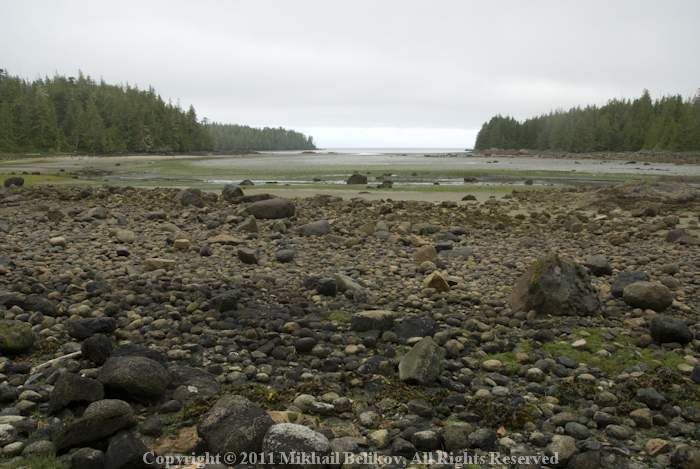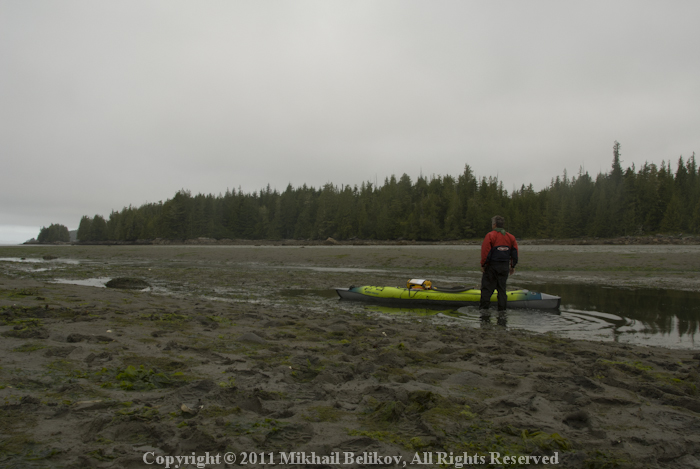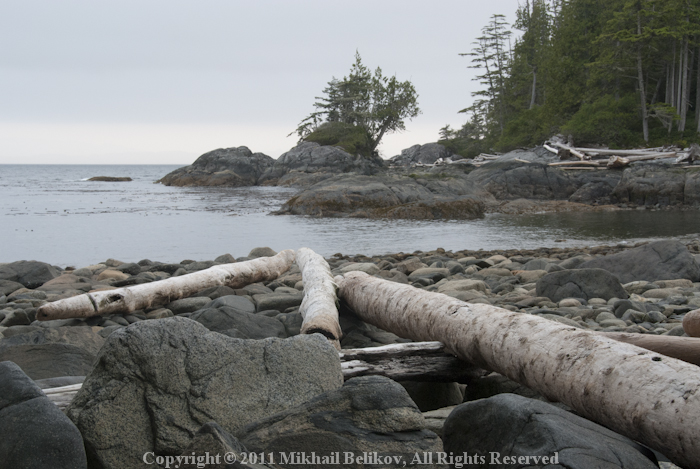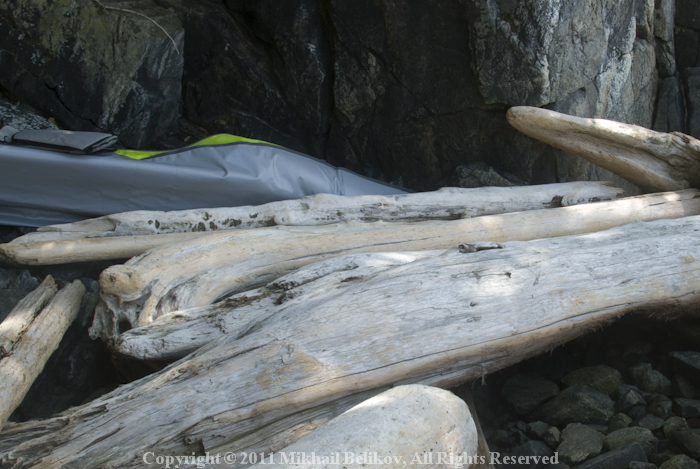Kayaking
Queen Charlotte Strait Solo
DAY 11: TO
AYLMER POINT
The alarm woke
me up at 3:30am. I did not sleep well,
keeping listening for a potential visitor. Fortunately, the bear did
not show
up. When I stepped outside, I could see that the tide was ebbing
fast. My
yesterday fear that I would get stuck in the dry bay was materializing.
While I
was portaging my stuff over an expanding tidal zone the bay
had dried up, except for a shallow stream in the middle.
When I put my kayak on water, the stream had already developed
impassable
rapids.
I had walked
all way along the stream to the end of the
dry zone, to check if there was a place from which I could launch the
kayak.
There was nothing, except launching on the ocean side, a few hundred
meters
away and with the surf. The portaging would have consumed more time
than waiting
until
the water came back to my departure area.
This
was disappointing, but I saw no other option but to wait for
the
tide returning in two hours, according to the tide tables.
While waiting, I had placed the kayak in a small pool connected to
the
stream, so far deep enough to keep the fully loaded kayak afloat.
The tide had finally come at 9:15am, flooding the
stream soon thereafter. I had immediately departed.
Two precious
hours of the quiet morning time were lost,
but the ocean was still calm. I was paddling along the coast, when I
saw a
strange-looking kayak, with a short mast, coming in my direction. Soon,
it was
close enough and I had changed my course to meet the paddler.
This was an
inflatable kayak with large dry bags placed
vertically behind the kayaker. The mast, about 1.5 meter tall, held a
microphone on the top and a camera much lower. Mark, the sole paddler
in the
kayak, was on a six-month journey, on his way to Prince Rupert, then
planning a
bushwalk through the forest. Talking about the adventurous spirits! He
was video
and audio recording his trip, with the plan to setup a website once he
was back
to civilization, and post his adventures there. After sharing with Mark
the
camping options along the shore that I was aware of, we parted.

In the hour
thereafter the wind and the waves had picked
up. Again, I could not fight the weather hitting me on the broad reach
course
and had to urgently seek a shelter. The best available option was a bay
just
east of Aylam Point. I had no trouble running to the bay with the
following
wind and the waves. Soon, I was under protection of Aylam Point:
virtually no
wind and only light waves close to the shore. The only confirmation of
the
turmoil outside was the white-cap covered sea, as long as one could
see.
The bay was a
vast tidal area chocked with the driftwood.
However,
I could not find any flat spot suitable for my tent, even
after
searching close to an hour and checking everything within the
reasonable
distance from the water edge, from the tree line to the rocky outcrops.
Finally, I had
located
a "raft": three logs deposited on the rocky shore, above the tide
line. The central log was almost flat, allowing for comfortable
sleeping. The
raft was
surrounded on north and east sides by uninviting vertical rocky walls,
capped
with the forest. The ocean was on the south side, separated by several
driftwood
logs, and piles of driftwood were to the west. As always, when
camping in or close to the tidal zone, with no obvious
way out, I had located an escape route, in case the sea would build up
or
anything else would force me to urgently leave the camp. It
was around 20 meters long, requiring to walk on
several interconnected driftwood logs that led to an opening in the
bushes on
the shore, likely an animal trail. I had no illusions: during the
storms
with the westerly winds, the bay would be the hell on earth. However,
with the
present south-west wind, the bay was well protected, and the escape
route was
giving me
a reliable way out before the situation deteriorated. Satisfied, I had settled in this
area and rested my kayak behind the raft, on a flat rocky outcrop.
I
had then pitched the tent atop of the raft, placing
it on a tarp and attaching to the logs with screws.
I then cooked my
dinner,
boiling extra water to refill my flask, and went to bed after
10:00pm. Some time into
the night I had started having dreams that
I was surrounded by water, splashing all over me. Then something had
forced me
to wake up. I could clearly hear the splashing water, next to my tent.
Before
pitching the tent, I had checked the tide line at the high tide in the
afternoon
-- it was well below my camp, so I could not believe that the ocean was
moving
on my camp. Still, to be sure, I put on my headlamp and stepped
outside. The
first things that I saw were my water bottles floating around me. This
tide was
much higher than the previous one, and the water kept rising. Quickly,
I had collected all my stuff, left on the ground next to the raft,
and moved
it on
the rocky outcrop, above the level of my tent. Then, as the water was
still
rising and already reaching the bottom of the raft, I had removed
everything
from the tent, also placing it on higher grounds. By that time it was
12:30am.
I had checked the tide table: the high tide was one hour away, at
1:30am.
I was
reluctant to remove my tent - this was more a mental barrier than
anything
else, meaning that I had to break my camp completely. However, the raft
was
already partially submerged, with the water splashing through the
joints and reaching
my tarp. Unhitching
the tent took just a minute: the only thing
that I had to do was to remove the loops from the screw
heads. Then
I waited. A
mink had passed by, likely following its own trail from a log to a log.
It was
definitely surprised to see a stranger, especially at such a late hour.
Meanwhile, the water had stopped rising and I realized that I could
have left
the tent standing. At 1:30am I pitched the tent again, and went to bed.
Copyright © 2011 Mikhail Belikov. All rights reserved.
© All text and photographs appearing on this site are the
property of Mikhail Belikov. They are protected by the copyright
laws and
are not to be copied, downloaded or reproduced in any
way without the written
permission of Mikhail Belikov.










